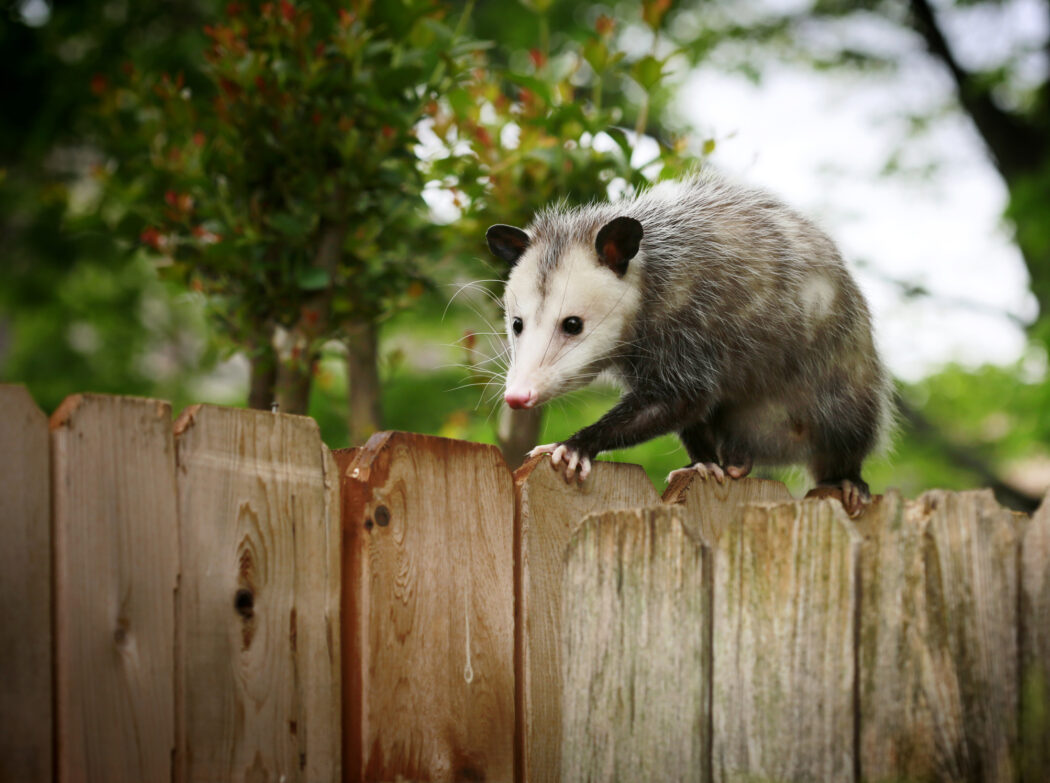
Opossums get a bad rap, there’s no doubt about it. They lurk in the dark, have sharp teeth and a menacing hiss and look like giant rodents. But if you happen to spot one in your East Dallas backyard, have no fear – and consider yourself lucky. These little guys are fascinating creatures that are beneficial to our shared ecology and worthy of our appreciation.
Did you know that opossums, as a group, are among the oldest, most primitive mammals? They walked the Earth with dinosaurs, looking pretty much the same in present day. Some scientists call them “living fossils” because they have survived relatively unchanged for at least 50 million years.
They are the only native marsupial in North America. Some believe these cousins of kangaroos and koalas were first observed by early English colonists. The word “opossum” derives from the Powhatan, an indigenous tribe from Virginia, and means “white beast.”
Sam Kieschnick, an Urban Biologist with the Texas Parks and Wildlife Department, is an enthusiastic fan of the opossum. “They’re incredibly interesting,” he says. “The ‘marsupium’ is the pouch where the young develop until they are mature enough to leave – and even then, they sometimes stay with the parent by riding the back.”
After a gestation period of only twelve days or so, the bee-sized babies crawl unaided into the mom’s pouch, where they remain to nurse and grow for seven weeks. They then hitch a ride on mom until they’re ready to leave on their own.
Another unusual feature: its scaly, nearly hairless tail is prehensile, meaning it can grasp things. “They’ll use it to carry leaves for their nests and dens or hold on to branches as they climb,” explains Kieschnick.
The opossum also has the distinction of being the only non-primate mammal with opposable thumbs on its paws, a handy thing for grasping trees.
Kieschnick mentions another unusual characteristic: “Opossums have 50 teeth – more than any other mammal in North America.” Now you know the origin of the old Southern expression “grinnin’ like a possum.”
And do they ever make use of those teeth? They are omnivores. Opossums eat pretty much everything, and much of their diet includes pests in your yard.
Roaches, beetles, ants, snails, grasshoppers, caterpillars – it’s all on the menu for them. Mice and rats? Sure, opossums will eat those. A bit of good news for those of us who suffer from ophidophobia: opossums seek out and quite enjoy an entrée of snake. Any snake, including, amazingly enough, the venomous kind. Rattlesnake? Yum, according to the opossum.
They also provide a complimentary clean-up of your yard by eating pests in your garden and by eating fresh carrion, nuts, and overripe, rotting fruit from trees.
Be aware that these nocturnal animals happily dine on any food you leave out for your pets or those feral cats. Be sure to have a tight-fitting lid on your garbage can. “They are one of the mammals that has adapted to living amongst us,” Kieschnick says. ”They are omnivores and opportunistic, so they will utilize any sort of available resources – in the urban ecosystem, sometimes this means our trash.” Just don’t blame opossums for a toppled can: a raccoon is more likely the culprit. Opossums aren’t above helping themselves to the result, but usually leave the heavy lifting to raccoons.
Perhaps most intriguing of all is this mammal’s defense mechanism: “playing possum.” When confronted with perceived danger, the opossum goes into a catatonic state. “Opossums lower their heart rate, slow their breathing, keep their mouth open and even stick out their tongue,” says Kieschnick, adding, “Not only do they look dead, but they ‘smell dead’ too,” by emitting a foul-smelling odor from their anal glands. “Perhaps this is an adaptation to prevent predators from eating a diseased corpse.”
Very dramatic scene, no doubt. But before you award the Oscar to our marsupial friend, consider breaking out the smelling salts instead: this death act is actually an involuntary reaction, not “playing.” It’s a physiological response to danger.
Julie Cassidy has seen a few opossums in her day. A volunteer for the DFW Wildlife Hotline and wildlife rehabber for the past twelve years, she estimates she has treated more than 800 opossums, most injured by a car or a dog attack.
It’s a fallacy that opossums are a threat to pets. Quite the contrary. “Pets are far more dangerous to opossums than they are to the pets,” Kieschnick advises. He urges pet owners to keep an eye on dogs when outside or bring them in, and always keep cats indoors.
Cassidy says if you encounter an opossum, leave it alone. But if it appears injured, contact the DFW Wildlife Hotline (972-234-9453) for guidance.
Kieschnick sums it up well. If you see an opossum, “Let it be,” he says. “Appreciate for a moment that urban wildlife can live amongst us.” Though we’ve removed the prairies and forests which were once theirs, opossums have rolled with it.
“Opossums have adapted to living with us – using some of our decks or sheds as a shelter, using the ditches along the roads as corridors, and even using some of our refuse as nutrients. They are a remnant of the past, the same sort of animal that early explorers or indigenous peoples would interact with – and we can still do that today.”
PATTI VINSON is a guest writer who has lived in East Dallas for more than 20 years. She’s written for the Advocate and Real Simple magazine.





